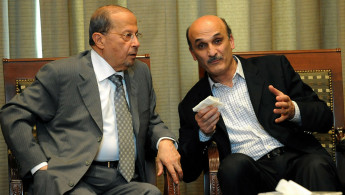Lebanon marks longest period without a president
Today marks Lebanon's 409th day without a president, the longest period in the country's history, reported Lebanon's Daily Star newspaper.
The Lebanese parliament has failed to elect a new president 25 times since Michel Suleiman's term ended on 25 May 2014.
There is, however, no sign of an end to the current deadlock, with the country's political alliances failing to agree on a new presidential candidate.
The Iranian-allied March 8 party bloc supports the candidacy of Michel Aoun, leader of the Free Patriotic Movement, while the Saudi-allied March 14 party bloc supports Samir Geagea, leader of the Lebanese Forces.
According to Lebanon's confessional political system the president is always a Christian, the prime minister a Sunni and the speaker of parliament a Shia.
The current presidential vacuum now exceeds the 408 day presidential crisis during the 1975-1990 civil war after Amine Gemayel’s term ended in September 1988. Rene Mouawad was eventually elected president in November 1989 after the Taif Accord was agreed that ended the civil war.
The last time Lebanon was without a president was for 60-days when Emile Lahoud's term ended on 24 November 2007.
This crisis ended in May 2008 after pro-Hizballah fighters took control of parts of West Beirut and clashed with the predominantly Druze Progressive Socialist Party in Lebanon's Chouf Mountains. Fighting was also seen in the northern Lebanese city of Tripoli.
Fighting broke out after the March 14 backed Siniora government tried to dismantle Hizballah's telecommunications network and sack Wafiq Shuqeir, head of Beirut's airport security and a close Hizballah ally. March 14 were acting after their officials complained about being monitored around the airport.
A total of 80 died in the fighting that ended with the Qatari-brokered Doha Accord. This led to the election of Sleiman as president on 25 May 2008 and the formation of a national unity government that gave March 8 veto power.





 Follow the Middle East's top stories in English at The New Arab on Google News
Follow the Middle East's top stories in English at The New Arab on Google News
![Netanyahu furiously denounced the ICC [Getty]](/sites/default/files/styles/image_330x185/public/2024-11/GettyImages-2169352575.jpg?h=199d8c1f&itok=-vRiruf5)
![Both Hamas and the Palestinian Authority welcomed the ICC arrest warrants [Getty]](/sites/default/files/styles/image_330x185/public/2024-11/GettyImages-2178351173.jpg?h=199d8c1f&itok=TV858iVg)
